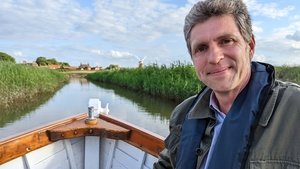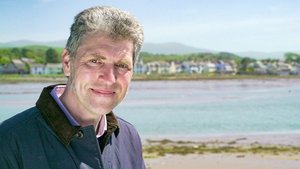
Situated on the eastern coast of the Isle of Man, the village of Laxey is known today as a tourist destination, but as archaeologist Ben Robinson finds out, it wasn’t the beaches and the mountains that attracted Victorian tourists, but an engineering marvel - the biggest waterwheel in the world. Ben meets local resident Matthew Boyd who is repairing and restoring the 22-metre-wide great wheel and finds out how it transformed this small mining community to one of the most successful in the British Isles. He meets mining historian Peter Geddes who takes Ben deep underground to experience first-hand some of the conditions the miners faced.

Archaeologist Ben Robinson explores Parkgate, on the estuary of the River Dee in Cheshire. Today the village is landlocked, cut off from the Dee and the Irish Sea due to the estuary’s shifting silt. But 250 years ago, it was a bustling harbour and as Ben finds out from Dr Gillian O’Brian, Parkgate was a gateway for thousands of Irish immigrants from the 1620s onwards. Local resident Anthony Annakin-Smith, who has been researching Parkgate’s past, explains to Ben it was the estuary’s ever-shifting silt that first established the village as an important trading port in the 18th century. Up to then, the Port of Chester had handled most of the trade along the Dee, but by the 1600s, its harbour was starting to silt up, allowing Parkgate to expand.

Lying off the North Sea is the unassuming Suffolk village of Orford. It’s behind a large shingle spit called Orford Ness. But as archaeologist Ben Robinson unearths, it’s been at the forefront of defending the British Isles for over 800 years. Today, its imposing castle built by Henry II is being conserved by English Heritage. Curator Dr Shelley Garland explains the process to Ben and how they’ve devised the best way to preserve its crumbling stonework.

Archaeologist Ben Robinson visits a small village in Northumberland to find out how the family and village who both share the name Craster have had their lives and fortunes intertwined for over 800 years. The village sits on a unique seam of rock called the Whin Sill and next to the North Sea. Ben learns how, through the generations, the Crasters have used local resources to make their fortunes and in turn have changed the face and the fortunes of the village and the villagers.

Archaeologist Ben Robinson uncovers the secrets of Cornwall’s Tintagel, famed as the legendary birthplace of King Arthur. Ben discovers Tintagel was potentially more important than London a thousand years ago, based on recent evidence unearthed at an archaeological dig overseen by English Heritage. It was found that over 2,000 people were living here which, at the time, which would have made it the largest settlement anywhere of its kind in Britain. In a 14th century house, Ben discovers the origins of a saying that’s still in use today with the help of Joanne McGillivray of the National Trust. Joanne explains unmarried woman would sleep on a platform accessed by a ladder, which would be drawn up at night to keep the woman away from men. But if they stayed up there and never married, they would be ‘left on the shelf’.

Archaeologist Ben Robinson visits the Norfolk village of Cley next the Sea and discovers that due to Dutch settlers in the Elizabethan era, it's not as ‘next the sea’ as it once was. Ben finds a village green that was once a thriving port with big ships and surrounded by a thriving village. He visits the church and meets Matt Champion, an expert in medieval graffiti who has found some incredible links to past villagers. A fire in the 1600s destroyed most of the original village, and Ben uses some detective work to try and date a house believed to be one of the only survivors. An exploration of the village reveals architecture that shows the influence of Flemish immigrants, but it's not only the buildings that were influenced by the so called ‘Elizabethan strangers’.

Archaeologist, Ben Robinson visits the east coast village of Flamborough which sits on a rugged headland sticking out into the North Sea. A largely unassuming village today, it was once effectively cut off from the rest of the country by a five-metre-deep, two-and-a-half-mile long man-made dyke, re-enforced and fortified with local chalk. As Ben discovers when he visits two of the village's most prominent structures, chalk plays a large part in the history of Flamborough. Built from chalk in the 1350s, Flamborough castle is now in ruins, but once belonged to an influential local family called the Constables. Using modern technology, Ben will build up a picture of what their vast, fortified estate might once have looked like.

Sitting on the east coast of Jersey, and about 14 miles from the coast of Normandy, the small village of Gorey was, for hundreds of years the frontline of defence between the British Isles and its enemy, the French. Archaeologist Ben Robinson follows the story of this small village’s history as an important military location, from the castle built in the 1200s to the experiences of the village in the second world war when occupied by Hitler’s army.

Archaeologist Ben Robinson takes us to the quiet village of Ravenglass, tucked away on the edge of the Lake District’s National Park, where he finds out about its strategic importance to the Roman empire. Ben explores the village and its surrounding area to uncover the remarkable evidence of its Roman past: unearthing Roman pottery, locating the earthworks of its fort and marvelling at one the best surviving examples of a Roman military bathhouse anywhere in Britain.